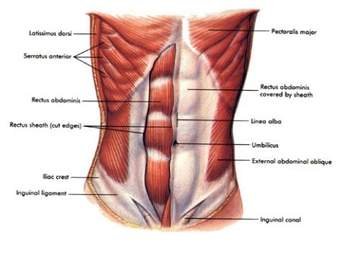The anatomy, physiology and clinical significance of the core muscles
The core refers to a group of muscles that wrap around the body and help with every functional movement. They both stabilize the body, maintain posture and balance, protects the spine and execute movements which are hitherto not possible without their functionality . The core muscles is the region from where every movement should ideally start. Therefore weakness of the core muscles is one of the leading causes of musculoskeletal injury.
The major muscles are the lower back and abdomen muscles- rectus abdominus and transversus abdominus both together called the abdominals, the obliques( the internal oblique and external oblique), the lower back muscles- the latissimus dorsi and the erector spinae and multifidus muscles. Also included in this group is the gluteal muscles which function as stabilizers for a variety of movements.
The four main abdominal muscles- 1. The rectus abdominus is a sheet of muscle which connects the sternum and the lower costal cartilages with the pelvic bone. It helps with flexion of lumbar spine. 2 the transversus abdominals which is the deepest muscle , extends from the lower costal cartilages to the iliac crest and goes down further to strap the psoas major muscle. 3. The obliques-the internal oblique lies below the external oblique . The internal oblique originates from the inguinal ligament and the anterior iliac crest. It runs diagonally up the side of the body to be inserted into the lower four costal cartilages. The external oblique originates from the lower 8 ribs and inserted into the linea alba, the pubic bone and the iliac crest. The obliques help in bending from side to side and twisting the body.
The back component of the core comprises of the spinal multifidus and the erector spinae muscles. Also vital significance is given to the lats though not part of the core.
The erector spinae refers to a group of muscles that starts from the back of the sacrum and between the buttocks, runs up along both the sides of the spine and ends to the spinous processes of the thoracic vertebrae. It aids extension of the spine.
The multifidus refers to multiple tendInous and fleshy fasciculi that run on either sides of the spinous processes of the vertebral column from the sacrum to the neck. Helps in extension of the spine, unilateral side bending and rotation to the contralateral side. This muscle is associates with the stability of the spine .These are short strips of muscle which connect 2, 3 or 4 adjacent spinous processes, passing obliquely upwards and
medically. They lie deeper to the other core muscles. Multifidus, comes in small strips but is a leading cause of back pain.
The latissimus dorsi, the trapezius and the glutes, though not classified under the core, play a major role in assisting the core muscles and helping in stability.
The base of these core muscles is formed by the pelvic floor- the sheet which is perforated by the urethra, rectum and vagina in women and the urethra and rectum in men. The core muscles along with the pelvic floor help in maintaining intra abdominal pressure during physiological processes like breathing, urination and defecation as well as during activities such as lifting.
The core muscles provide strength and make daily activities easier. They help with balance and stability and hence reduces the risk of injuries. Training the core helps in maintaining a good physique. It helps with maintenance of a good posture. For the athletes, a stronger core give more endurance and less fatigue. A strong core prevents low back pain. Having a strong core is a great asset
A strong core should be every lady’s possession to aid in recovery from physiological phases like pregnancy and childbirth. To work on the core post delivery helps in avoiding complications like hernias and prolapse. Not to mention that getting back the prepregnancy core strength and stability does the woman’s psyche tons of good.

